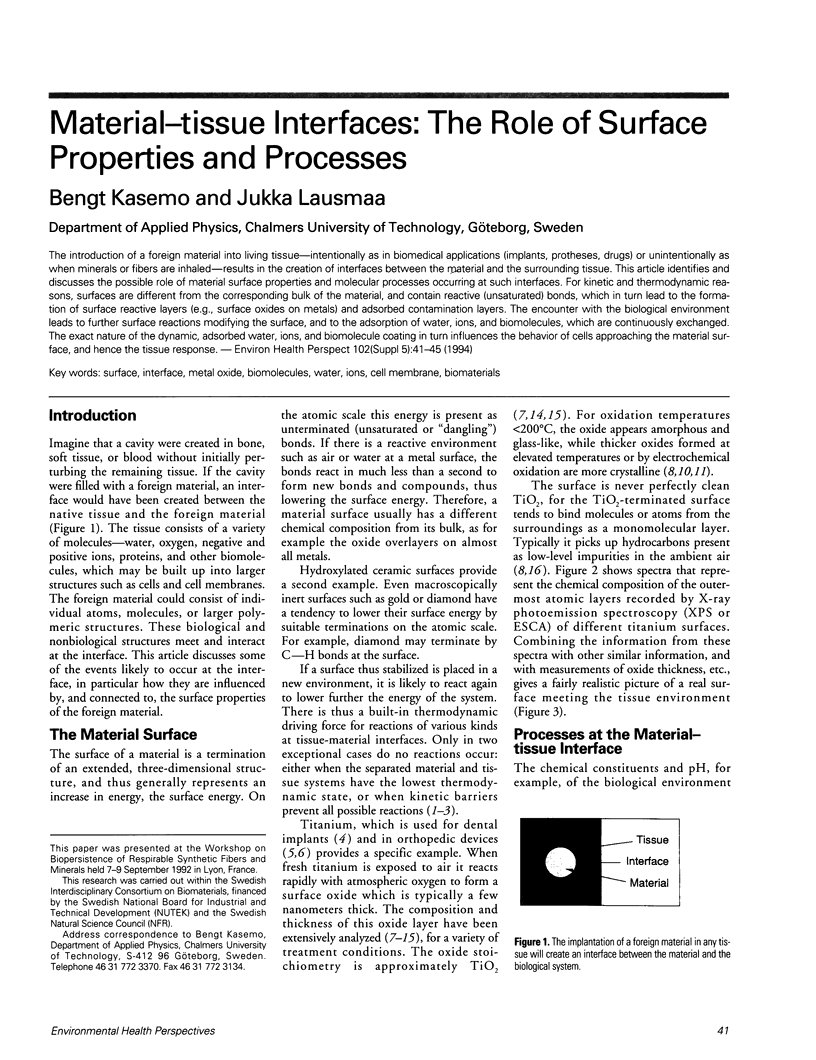Abstract
The introduction of a foreign material into living tissue--intentionally as in biomedical applications (implants, protheses, drugs) or unintentionally as when minerals or fibers are inhaled--results in the creation of interfaces between the material and the surrounding tissue. This article identifies and discusses the possible role of material surface properties and molecular processes occurring at such interfaces. For kinetic and thermodynamic reasons, surfaces are different from the corresponding bulk of the material, and contain reactive (unsaturated) bonds, which in turn lead to the formation of surface reactive layers (e.g., surface oxides on metals) and adsorbed contamination layers. The encounter with the biological environment leads to further surface reactions modifying the surface, and to the adsorption of water, ions, and biomolecules, which are continuously exchanged. The exact nature of the dynamic, adsorbed water, ions, and biomolecule coating in turn influences the behavior of cells approaching the material surface, and hence the tissue response.
Full text
PDF




Selected References
These references are in PubMed. This may not be the complete list of references from this article.
- Healy K. E., Ducheyne P. Hydration and preferential molecular adsorption on titanium in vitro. Biomaterials. 1992;13(8):553–561. doi: 10.1016/0142-9612(92)90108-z. [DOI] [PubMed] [Google Scholar]
- Healy K. E., Ducheyne P. The mechanisms of passive dissolution of titanium in a model physiological environment. J Biomed Mater Res. 1992 Mar;26(3):319–338. doi: 10.1002/jbm.820260305. [DOI] [PubMed] [Google Scholar]
- Jacobs J. J., Skipor A. K., Black J., Urban R. m., Galante J. O. Release and excretion of metal in patients who have a total hip-replacement component made of titanium-base alloy. J Bone Joint Surg Am. 1991 Dec;73(10):1475–1486. [PubMed] [Google Scholar]
- Kasemo B., Lausmaa J. Biomaterial and implant surfaces: a surface science approach. Int J Oral Maxillofac Implants. 1988 Winter;3(4):247–259. [PubMed] [Google Scholar]
- Kasemo B., Lausmaa J. Biomaterial and implant surfaces: on the role of cleanliness, contamination, and preparation procedures. J Biomed Mater Res. 1988 Aug;22(A2):145–158. doi: 10.1002/jbm.820221307. [DOI] [PubMed] [Google Scholar]
- Rådegran G., Lausmaa J., Mattsson L., Rolander U., Kasemo B. Preparation of ultra-thin oxide windows on titanium for TEM analysis. J Electron Microsc Tech. 1991 Sep;19(1):99–106. doi: 10.1002/jemt.1060190110. [DOI] [PubMed] [Google Scholar]
- Smith D. C., Pilliar R. M., Metson J. B., McIntyre N. S. Dental implant materials. II. Preparative procedures and surface spectroscopic studies. J Biomed Mater Res. 1991 Sep;25(9):1069–1084. doi: 10.1002/jbm.820250903. [DOI] [PubMed] [Google Scholar]
- Tengvall P., Lundström I. Physico-chemical considerations of titanium as a biomaterial. Clin Mater. 1992;9(2):115–134. doi: 10.1016/0267-6605(92)90056-y. [DOI] [PubMed] [Google Scholar]
- Williams D. F. Titanium as a metal for implantation. Part 2: biological properties and clinical applications. J Med Eng Technol. 1977 Sep;1(5):266–270. doi: 10.3109/03091907709162192. [DOI] [PubMed] [Google Scholar]
- Woodman J. L., Jacobs J. J., Galante J. O., Urban R. M. Metal ion release from titanium-based prosthetic segmental replacements of long bones in baboons: a long-term study. J Orthop Res. 1984;1(4):421–430. doi: 10.1002/jor.1100010411. [DOI] [PubMed] [Google Scholar]


